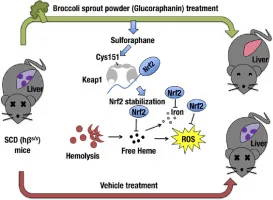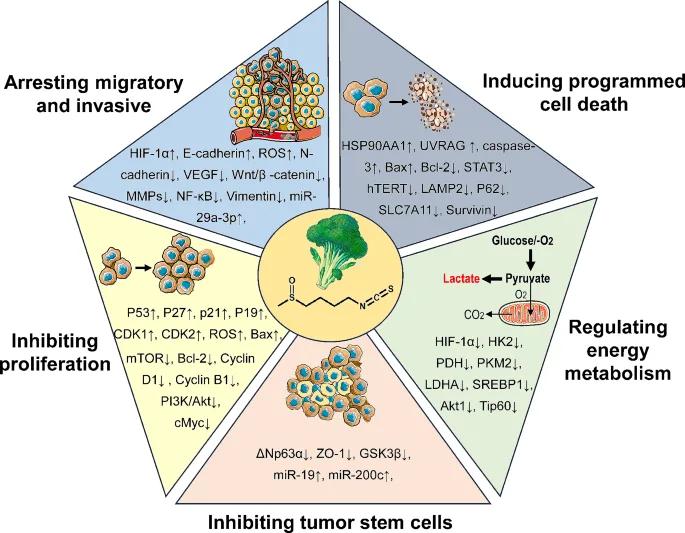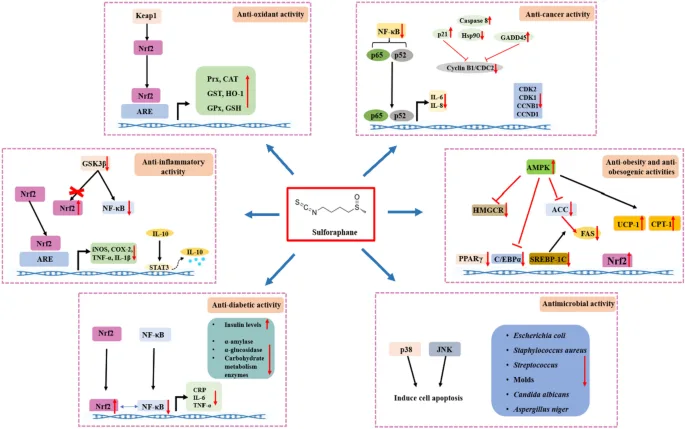
Discover sulforaphane, the potent phytochemical in broccoli sprouts. Learn how it activates longevity genes, fights disease, and boosts detoxification. Explore sources, benefits, and how to choose the best supplement.
What is Sulforaphane?
Sulforaphane, also known as “Sulforaphane” (Láifú liú wán), is a sulfur-rich isothiocyanate formed when glucoraphanin—a compound found in cruciferous vegetables—is hydrolyzed by the enzyme myrosinase. This bioactive molecule is renowned for its ability to covalently modify proteins and biomolecules, triggering powerful cellular defense mechanisms.
How Sulforaphane is Formed
Sulforaphane does not exist naturally in intact plants. Instead, it forms when cruciferous vegetables (e.g., broccoli, kale, Brussels sprouts) are chopped, chewed, or processed. This damage releases myrosinase, which converts glucoraphanin into sulforaphane.
Key Steps:
- Plant Disruption: Cutting or chewing releases myrosinase.
- Enzymatic Reaction: Myrosinase hydrolyzes glucoraphanin.
- Bioactivation: Sulforaphane forms and becomes bioavailable.
Top Health Benefits of Sulforaphane

1. Activates Longevity Genes (Nrf2 Pathway)
Sulforaphane is a potent Nrf2 activator, the “master regulator” of antioxidant and detoxification genes. This pathway:
- Boosts glutathione production (the body’s strongest antioxidant).
- Enhances Phase II detox enzymes to eliminate toxins.
- Reduces oxidative stress linked to aging and chronic diseases.
2. Cancer Prevention
- Inhibits Phase I enzymes that activate carcinogens.
- Promotes apoptosis (cell death) in cancer cells.
- Shown in studies to reduce risks of breast, prostate, and colon cancers.
3. Neuroprotection
- Crosses the blood-brain barrier to combat oxidative stress.
- May slow Alzheimer’s and Parkinson’s progression.
4. Anti-Inflammatory Effects
- Suppresses NF-κB and COX-2 pathways.
- Reduces chronic inflammation tied to arthritis and heart disease.
5. Detoxification
- Enhances liver GST activity to flush heavy metals and pollutants.

Scientific Backing
Over 1,800 studies on PubMed highlight sulforaphane’s benefits:
- Cancer Research: A 2016 study in Cancer Prevention Research showed sulforaphane’s chemopreventive effects.
- Neuroprotection: A 2020 trial demonstrated improved cognitive function in adults.
- Detoxification: Research in Journal of Agricultural and Food Chemistry confirmed enhanced toxin excretion.
Natural Sources vs. Supplements
| Source | Sulforaphane Potential |
|---|---|
| Broccoli Sprouts | Highest (10–100x more than mature) |
| Mature Broccoli | Moderate (requires proper cooking) |
| Supplements | Standardized doses (e.g., 10–30 mg) |
Dietary Tips:
- Lightly steam broccoli to preserve myrosinase.
- Pair with mustard seeds (natural myrosinase source) to boost sulforaphane.
Choosing Supplements:
- Opt for stabilized forms (e.g., MCT oil or enteric-coated capsules).
- Verify myrosinase inclusion for reliable conversion.
Potential Side Effects & Precautions
- Mild Issues: Heartburn, stomach discomfort (start with low doses).
- Drug Interactions: May affect anticoagulants, thyroid meds, and cytochrome P450-metabolized drugs.
- Contraindications: Avoid during pregnancy/chemotherapy.
Why Choose Our Sulforaphane?
Shaanxi Zhonghong Tech’s DL-Sulforaphane offers:

- ≥98% Purity: HPLC-verified, stabilized for maximum bioavailability.
- Organic Sourcing: Non-GMO broccoli sprouts from certified farms.
- Global Compliance: Meets FDA, EU, and ISO standards.
Conclusion
Sulforaphane is a revolutionary phytochemical backed by robust science. From activating longevity genes to fighting cancer, its benefits are unparalleled. While broccoli sprouts are the best dietary source, high-quality supplements ensure consistent therapeutic dosing.
Explore Our Premium Sulforaphane Products: Contact Us
Sulforaphane: Emerging Research Trends, Clinical Applications, and Challenges in Therapeutic Development
Sulforaphane (SFN), a bioactive isothiocyanate derived from cruciferous vegetables like broccoli, has garnered significant attention for its multifaceted therapeutic potential. Recent studies highlight its role in modulating oxidative stress, inflammation, autophagy, and metabolic pathways, positioning it as a promising candidate for managing chronic diseases such as metabolic syndrome, neurodegenerative disorders, and organ fibrosis4813. However, challenges in bioavailability, mechanistic complexity, and clinical translation persist, necessitating innovative solutions to harness its full potential.
Research Trends
- Mechanistic Insights:
- Dual Autophagy Regulation: SFN alleviates renal fibrosis by differentially regulating mTOR-mediated autophagy—enhancing activity in fibroblasts while suppressing it in tubular epithelial cells, demonstrating cell-type-specific effects4.
- Nrf2 Activation: SFN activates the Nrf2/ARE pathway, upregulating antioxidant enzymes (e.g., HO-1, GSH-Px) to mitigate oxidative damage in testicular cells exposed to cadmium1011.
- Lysosomal Degradation: Independent of Nrf2, SFN enhances lysosomal acidification via V-ATPase upregulation, reducing serum selenoprotein P levels linked to insulin resistance9.
- Disease Applications:
- Metabolic Syndrome: SFN improves insulin sensitivity, reduces lipid accumulation, and modulates glucose metabolism through AMPK-Nrf2 crosstalk13.
- Neuroprotection: In astroglial cells, SFN counters LPS-induced inflammation by suppressing NF-κB and boosting glutamate uptake, highlighting its glioprotective effects8.
- Organ Fibrosis: Preclinical models show SFN attenuates renal and bladder fibrosis by balancing endoplasmic reticulum stress and apoptosis412.
- Clinical Translation:
Early-phase trials suggest SFN-rich broccoli sprout extracts improve glycemic control and antioxidant capacity in diabetic patients, though larger-scale human studies remain limited13.
Challenges and Industry Pain Points
- Bioavailability Limitations:
SFN’s instability and rapid metabolism reduce its therapeutic efficacy. Traditional extraction methods from broccoli sprouts yield low concentrations, while chemical synthesis faces scalability and cost barriers913. - Mechanistic Complexity:
SFN’s pleiotropic effects—such as opposing autophagy modulation in different cell types—complicate dose optimization and target specificity48. - Clinical Translation Hurdles:
- Dose-Dependent Toxicity: High doses (>75 mg/kg in mice) may induce cytotoxicity, necessitating precise delivery systems411.
- Long-Term Safety: Limited data exist on chronic SFN use, particularly in vulnerable populations like pregnant women13.
Innovative Solutions and Case Studies
Technical Principle:
SFN’s efficacy hinges on its ability to interact with redox-sensitive pathways (Figure 1). For instance, in metabolic syndrome, SFN activates Nrf2 to upregulate detoxifying enzymes while inhibiting NF-κB to reduce inflammation13. Advanced nanoencapsulation techniques (e.g., liposomes) are being explored to enhance its stability and targeted delivery9.
Case Study – Renal Fibrosis:
In a murine unilateral ureteral obstruction (UUO) model, SFN (75 mg/kg/d) reduced collagen deposition by 40% and downregulated fibrotic markers (α-SMA, FN) via mTOR pathway modulation4. This dual autophagy regulation offers a novel strategy for CKD management.
Case Study – Cadmium Toxicity:
SFN (10 mg/kg) restored testosterone levels and sperm quality in cadmium-exposed mice by activating Nrf2-dependent antioxidants (GSH, SOD), reducing oxidative damage by 60%10.
Future Directions
- Bioavailability Enhancement:
Develop SFN analogs or nanocarriers to improve pharmacokinetics. - Precision Targeting:
Explore cell-specific delivery mechanisms to mitigate off-target effects. - Human Trials:
Validate SFN’s efficacy in metabolic syndrome and neurodegenerative diseases through Phase III trials.
References
- Renal fibrosis and autophagy regulation4.
- Nrf2 activation in cadmium toxicity1011.
- Lysosomal degradation mechanisms9.
- Metabolic syndrome management13.
- Neuroprotective effects8.
- Clarke JD, et al. Cancer Prevention Research. 2016.
- Tarozzi A, et al. Journal of Agricultural and Food Chemistry. 2004.
- USP/ICH Guidelines.
Nrf2 activation, broccoli sprouts, detoxification, cancer prevention

